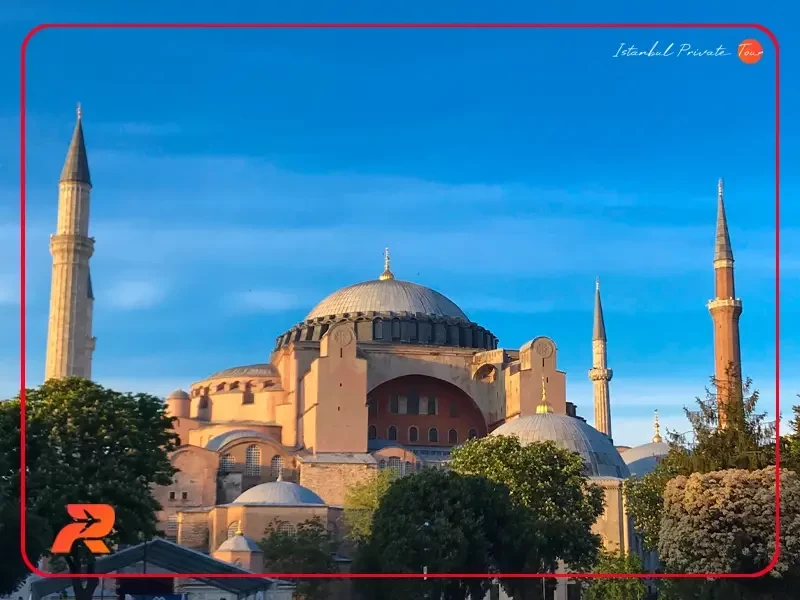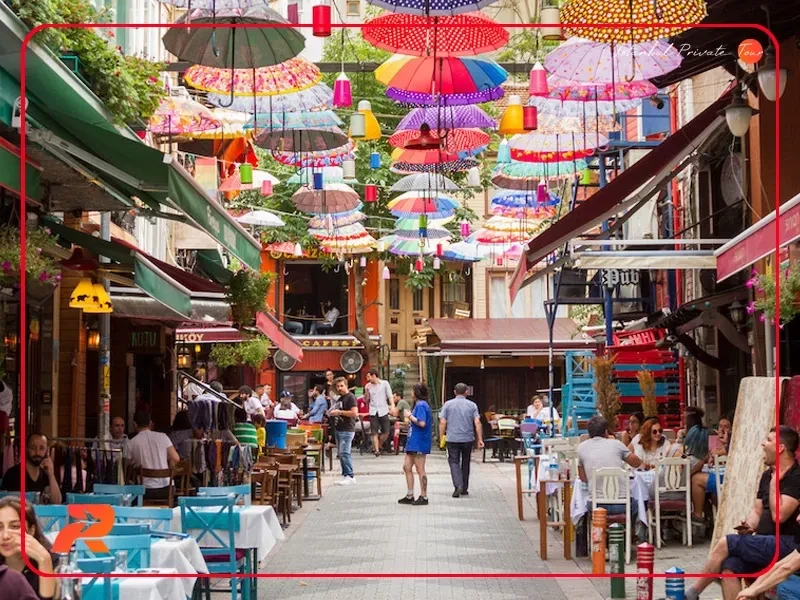Hagia Sophia Museum and Mosque

Hagia Sophia is a testament to human ingenuity. It's a symbol of the rich tapestry of history that Istanbul, once Constantinople, has woven over centuries.
Originally built as a cathedral in 537 AD, it was the crowning glory of the Byzantine Empire. Its massive dome, an architectural marvel, changed the course of architecture forever.
But the Byzantine era was just the beginning. The Ottoman conquest in 1453 marked a new chapter for Hagia Sophia. It was transformed into a mosque, with Islamic elements like minarets and a mihrab added to its structure.
The story didn't end there. In 1935, Mustafa Kemal Atatürk, the founder of modern Turkey, secularized Hagia Sophia. It was converted into a museum, a symbol of Turkey's commitment to its diverse heritage.
Yet, the saga continues. In 2020, a decision to reconvert Hagia Sophia into a mosque sparked international reactions. This move highlighted the building's complex history and its role in ongoing political and religious debates.
Inside, Hagia Sophia is a fusion of cultures. Christian mosaics coexist with Islamic calligraphy, a visual representation of its layered past. The central nave, galleries, and the Imperial Gate each tell a story of power, faith, and transformation.
Hagia Sophia's influence extends beyond its walls. It has shaped mosque architecture, inspired Renaissance architects, and featured in art, literature, and popular culture. It's not just a building, but a symbol of Istanbul's historical and cultural identity.
Today, Hagia Sophia stands as a UNESCO World Heritage Site. It's a testament to the city's resilience and its ability to adapt and evolve. It's a beacon for tourists, a subject of academic studies, and a source of national pride.
But Hagia Sophia is also a site of contention. Balancing its religious function with its historical significance is a challenge. Its future, like its past, is likely to be marked by change and debate.
This article will take you on a journey through Hagia Sophia's history.
We'll delve into its architectural marvels, cultural importance, and role in modern Istanbul, tracing its journey from Byzantine roots, through its Ottoman evolution, to its status as both a museum and mosque.
Let's explore the story of Hagia Sophia, a building that has endured through history, survived empires, and still fascinates people worldwide.
The Majestic History of Hagia Sophia
Hagia Sophia's history is vast and layered. It's a monument that reflects the shifting sands of empires and the passage of time. Over the centuries, it has served as a cathedral, mosque, and museum. Each transformation reflects the cultural and political shifts that have shaped its story.
Hagia Sophia originally started as a Byzantine cathedral and remained the largest Christian church globally for almost 1,000 years.
It stood as a symbol of the Byzantine Empire's spiritual and political prowess. This era of opulence and grandeur laid the foundation for its lasting legacy.
The arrival of the Ottomans in 1453 heralded a new era for Hagia Sophia. The building was converted into a mosque, symbolizing the might and sophistication of the new rulers. This transformation marked a major shift in religious and cultural identity.
The 20th century saw another seismic change with Atatürk's vision of secularism. He transformed Hagia Sophia into a museum, a move that aimed to honor Turkey's diverse heritage. This decision was pivotal in reimagining Hagia Sophia's role in a modern, secular state.
Yet, even in recent years, Hagia Sophia's role continues to evolve. The 2020 reconversion into a mosque reignited discussions about its cultural and religious identity. This change has underscored its multifaceted significance and ongoing relevance.
The Byzantine Beginnings and Architectural Revolution
The construction of Hagia Sophia began under Emperor Justinian I in 532 AD. It was completed in a mere five years, an astonishing feat for the time. The emperor's ambition was to create a masterpiece that would surpass all others in grandeur.
The architectural design of Hagia Sophia was revolutionary. Its massive dome, supported by pendentives, was a groundbreaking innovation. This structure allowed the dome to seem as if it were floating atop the building, a sight that left many awestruck.
The interior of Hagia Sophia was adorned with opulent decorations. Mosaics crafted with gold and precious stones told biblical stories, illuminating the space. These artistic elements captured the religious devotion and wealth of the Byzantine Empire.
This architectural wonder set a precedent for future structures. Its influence extended beyond its immediate geography and era, impacting the architectural designs that followed. Hagia Sophia became a benchmark for domed constructions worldwide.
Hagia Sophia’s early history reflects the peak of Byzantine art and ambition. It was not just a place of worship but a tangible manifestation of imperial power. The building encapsulated the Byzantine's blend of spiritual and temporal authority.
The Ottoman Conquest: A New Chapter as a Mosque
In 1453, Constantinople fell to the Ottomans, signaling the end of Byzantine rule. Sultan Mehmed II marked his victory by converting Hagia Sophia into a mosque. This transformation was as much political as it was religious.
The Ottomans added minarets to Hagia Sophia, altering its skyline. These tall, slender towers became integral to its mosque identity. They offered a new aesthetic that blended seamlessly with the Byzantine base.
Inside, the Ottomans introduced Islamic elements. The mihrab, indicating the direction of Mecca, and the minbar for sermons, were significant additions. These changes highlighted the mosque's new Islamic role while retaining its architectural grandeur.
The mosaics depicting Christian scenes were covered in plaster. This act was meant to align the interior with Islamic tenets. Yet, the Ottomans preserved the structure's integrity, respecting its architectural magnificence.
Hagia Sophia as a mosque became a centerpiece of Ottoman Istanbul. It was a symbol of the empire's strength and its cultural melding. This era underscored the building's adaptability and enduring significance across different faiths and cultures.
Secularization: The Transformation into a Museum
In 1935, Turkey underwent a transformation under the leadership of Mustafa Kemal Atatürk. One of his significant reforms was converting Hagia Sophia into a museum. This move was a nod to secularism and cultural inclusivity.
The decision reflected Turkey's new identity as a modern secular state. It aimed to create a neutral space where the nation's diverse cultural and religious history could coexist. Hagia Sophia thus became a repository of Turkey's multifaceted heritage.
As a museum, Hagia Sophia opened its doors to the world. Visitors could now experience its architectural brilliance and historical depth firsthand. This transition allowed for a broader appreciation of its artistic and cultural significance.
Restoration efforts uncovered the hidden mosaics, revealing the Christian artistry beneath the plaster. These restorations were crucial in preserving Hagia Sophia's dual religious legacy. The blend of Byzantine and Ottoman elements became a defining feature.
Hagia Sophia as a museum served as a symbol of peaceful coexistence. It highlighted the importance of acknowledging and preserving diverse cultural heritages within a single national identity. This phase was as significant as its previous religious incarnations.
The Recent Reconversion Controversy
In July 2020, Turkey's government announced that Hagia Sophia would once again function as a mosque. This decision sparked significant debate both domestically and internationally. It raised questions about cultural heritage and religious identity.
The reconversion was seen as a reclamation of the site's Islamic heritage. For many, it was a source of pride and a return to the site's Ottoman roots. However, it also sparked concerns about Turkey's commitment to secularism.
Internationally, reactions were varied. UNESCO expressed regret, emphasizing Hagia Sophia’s universal significance. Many viewed the decision as a cultural and political statement impacting Hagia Sophia's status as a World Heritage Site.
Despite its status as a mosque, Hagia Sophia remains open to visitors. The dual function highlights ongoing discussions about the balance between religious function and historical preservation. These debates are a testament to the site's enduring complexity.
The reconversion of Hagia Sophia underscores its dynamic role in modern Turkey. Its future will likely continue to reflect broader cultural and political shifts. What remains constant is its ability to inspire and provoke dialogue across the globe.
Exploring the Hagia Sophia Interior
Stepping inside Hagia Sophia is a journey through centuries of history. The interior is a feast for the senses, with its awe-inspiring scale and intricate details. Every corner of this architectural marvel holds stories from different eras.
The vastness of the space is immediately striking. The main nave, an expansive area, gives visitors a sense of the building's grandeur. This open space has hosted countless religious ceremonies and imperial processions over the ages.
The building's interior reflects a unique blend of cultures. Byzantine mosaics coexist with Islamic calligraphy, creating a dialogue between two distinct artistic traditions. This fusion speaks to the complex history of Hagia Sophia.
Natural light plays a crucial role in accentuating the interior's beauty. Numerous windows encircle the base of the dome, allowing daylight to pour in. This illumination creates a heavenly atmosphere that changes throughout the day.
The central dome is an architectural wonder, hovering above the nave. Its design revolutionized construction in its time. It is this dome that captures much of Hagia Sophia's majesty and technical brilliance.
Intricate marble columns line the interior, each with its own story. They come from different regions, reflecting the Byzantine Empire’s vast reach. These columns contribute to the sacred ambiance that defines the interior.
The echoes within Hagia Sophia are mesmerizing. They enhance the acoustic experience, making sound an integral part of the spiritual atmosphere. This quality has long been a hallmark of Hagia Sophia's design.
For visitors, exploring the interior is a moving experience. Whether contemplating the art, architecture, or the air of history, Hagia Sophia continues to inspire awe and admiration. The interior invites a deep appreciation of both beauty and history.
A Glimpse into the Glorious Dome
The dome of Hagia Sophia stands as a testament to architectural genius. Its vast span and height defy the imagination, a feat few structures have replicated. Known for its grandeur, the dome gives a sense of floating in mid-air.
This architectural marvel is supported by pendentives, a key innovation of its time. These triangular sections allowed the dome to transition gracefully onto the building's massive square base. This design has influenced countless structures over the centuries.
Decorative elements within the dome enhance its visual impact. While originally adorned with mosaic art, it now features Islamic calligraphy from its mosque era. These adornments add layers of beauty to the dome's immense form.
The dome isn’t just a visual spectacle; it embodies centuries of faith and art. It reflects the aspirations of both the Byzantine and Ottoman empires. The structure, with its historical and cultural significance, remains central to Hagia Sophia's legacy.
The Fusion of Christian Mosaics and Islamic Calligraphy
Hagia Sophia is a canvas of diverse religious art. Its walls tell a story through the delicate balance of mosaics and calligraphy. These elements show the cultural intersections that make Hagia Sophia unique.
Christian mosaics are a defining feature of the interior. Made during the Byzantine era, these mosaics depict scenes from the Bible and figures such as Christ and the Virgin Mary. They bring a sense of spiritual reverence to the space.
When transformed into a mosque, Islamic calligraphy was added. Arabic inscriptions grace the structure, highlighting verses from the Quran. This addition reflects the building's role as a place of Islamic worship.
Together, the mosaics and calligraphy create an artistic dialogue. They represent a harmonious blend of Byzantine and Ottoman artistry. This fusion stands as a powerful testament to Hagia Sophia's complex religious history.
Preserving these artworks is vital to maintaining Hagia Sophia's multifaceted identity. Efforts have ensured that both the mosaics and calligraphy continue to coexist. This coexistence is key to understanding Hagia Sophia's enduring cultural significance.
Hagia Sophia's Architectural Significance
Hagia Sophia stands as an icon of architectural innovation. Its construction introduced groundbreaking techniques that continue to influence modern architecture. The building exhibits a blend of form and functionality, a hallmark of its lasting appeal.
This remarkable structure challenges traditional architectural norms. Its combination of a vast interior space with a towering dome was unprecedented in its time. Architects marveled at its design, which still inspires awe today.
Hagia Sophia combines geometric precision with aesthetic beauty. The layout is meticulously planned, merging structural stability with intricate decoration. This harmony is a key aspect of its architectural genius.
The use of light in Hagia Sophia is intentional and dramatic. Light floods through strategically placed windows, creating a celestial effect. This design choice enhances the spiritual experience of those inside.
The building's structural system was revolutionary. Engineers employed innovative methods, allowing the dome to rest securely atop the base. This ingenuity paved the way for future architectural developments.
Materials used in construction were chosen for both durability and beauty. Marble and stone form the core, while decorative elements add visual splendor. This combination showcases both strength and elegance.
Hagia Sophia's structural innovations were widely admired. Its design features have been replicated and adapted in numerous buildings. These adaptations demonstrate its enduring influence on global architecture.
Ultimately, Hagia Sophia is more than just a building. It symbolizes human ingenuity and cultural fusion. Its architectural significance remains crucial in understanding the evolution of design throughout history.
Engineering Marvels: Pendentives and Buttresses
The engineering behind Hagia Sophia's dome is a marvel. Pendentives played a pivotal role in supporting the dome, allowing it to span a large area. These triangular segments connect the dome to its square base seamlessly.
Pendentives distribute the weight of the dome efficiently. This was a revolutionary solution that allowed for a more expansive interior space. By mastering this technique, architects achieved a harmonious blend of scale and stability.
In addition to pendentives, buttresses provide further support. These architectural features absorb and divert the weight, safeguarding the structure. Their use was crucial in managing the immense pressures exerted by the dome.
Together, pendentives and buttresses represent a leap in architectural innovation. They ensured not only the dome's stability but also the building's longevity. Today, these features continue to be studied and admired by architects worldwide.
The Influence on Mosque Architecture
Hagia Sophia's impact extended to mosque architecture. Its iconic dome and design principles greatly influenced Ottoman architects. Sultan Ahmet Mosque, among others, drew inspiration from its architectural blueprint.
The spaciousness of Hagia Sophia inspired the layout of many mosques. The sense of openness and airiness became desirable traits in sacred spaces. This influence is evident in mosques across the Ottoman Empire.
Architectural elements like domes and minarets became integral to mosque design. These features facilitated a profound spiritual experience, much like Hagia Sophia's interiors. Their adoption illustrates the cross-cultural exchange of architectural ideas.
In conclusion, Hagia Sophia set a new standard in construction and design. It remains a model for mosque architecture, its legacy imprinted across continents. The architectural features championed by Hagia Sophia have thus transcended cultural and temporal boundaries.
Hagia Sophia in the Context of Empires
Hagia Sophia stands at the intersection of history and power. Its story is intertwined with the rise and fall of empires. Each empire that governed Hagia Sophia left an indelible mark on its legacy.
Throughout its existence, the monument has witnessed significant historical events. Coronations, religious ceremonies, and political shifts have all echoed within its walls. It reflects the aspirations and achievements of those who ruled over it.
Hagia Sophia's grandeur symbolizes imperial authority and religious unity. Both the Byzantine and Ottoman empires leveraged its significance to project power. As such, it played a central role in the political and spiritual life of its rulers.
This architectural masterpiece has continually adapted to its empire's needs. Hagia Sophia has undergone modifications to align with varying cultural and religious contexts. Its ability to transform has helped it endure the test of time.
Symbol of the Byzantine Empire
Hagia Sophia began as a beacon of Byzantine power. Constructed under Emperor Justinian I in 537 AD, it embodied imperial grandeur. The cathedral showcased the empire's architectural prowess and religious devotion.
The Byzantine Empire used Hagia Sophia to assert its dominance. Its construction signaled the empire's wealth and ingenuity. It was a center for Orthodox Christianity, emphasizing the unity of church and state.
Inside, the mosaics celebrated Christian iconography. These intricate designs reinforced the religious authority of the Byzantine rulers. The mosaics communicated theological narratives to believers and visitors alike.
Hagia Sophia hosted significant events such as imperial coronations. These ceremonies highlighted the link between the Byzantine emperor and divine authority. Through these rituals, the empire showcased its power and religious significance.
The Ottoman Legacy and Hagia Sophia
In 1453, the Ottomans conquered Constantinople. Hagia Sophia was transformed into a mosque, marking the rise of a new empire. This conversion reflected the shift in power and religious orientation.
Ottoman sultans added Islamic features to Hagia Sophia. Minarets, mihrabs, and calligraphy integrated Islamic identity into the structure. These additions emphasized the Islamic influence while respecting the building's essence.
Hagia Sophia became an important mosque in the Ottoman Empire. It was central to religious and cultural activities within the capital. Its continued use demonstrated the empire's respect for its historical importance.
The Ottomans preserved much of Hagia Sophia's heritage. Their stewardship maintained the building's structural and artistic integrity. Through this, Hagia Sophia remained a symbol of continuity and adaptation through centuries.
The Role of Hagia Sophia in Art and Culture
Hagia Sophia is a muse for countless artists and writers. Its grandeur and history have inspired art and literature globally. Many creators have turned to this monument for inspiration.
The building's mystique appears in novels and poems. Writers explore its history and architectural beauty. It symbolizes the confluence of different cultures and religions.
Artists have captured Hagia Sophia's iconic silhouette for centuries. They depict its distinctive dome and minarets in various mediums. Paintings, drawings, and photographs celebrate its architectural elegance.
Modern culture embraces Hagia Sophia's legacy too. Films and documentaries focus on its historical significance. These works allow global audiences to engage with its story.
Cultural scholars study Hagia Sophia's impact across time. They analyze its influence on Byzantine and Ottoman arts. Its legacy continues to inform scholarly research and discussions.
The Hagia Sophia is more than a structure; it is a cultural icon. Its influence extends beyond architecture into every cultural realm. Through art and literature, its spirit endures and inspires.
Hagia Sophia in Literature and Popular Culture
Hagia Sophia serves as a compelling backdrop in literature. Authors weave its rich history into their narratives, enhancing their tales. This practice helps readers connect with the monument's historical layers.
In popular culture, Hagia Sophia represents a meeting of East and West. It symbolizes interfaith dialogue and multiculturalism. Filmmakers and storytellers use it to explore these themes.
Documentaries and films highlight its architectural marvels. They delve into its transformation through time. These visual stories bring Hagia Sophia closer to viewers worldwide, extending its legacy.
The Artistic Features: Mosaics and Calligraphy
The interior of Hagia Sophia dazzles with artistic wonders. Its mosaics boast detailed Christian iconography. These artworks portray religious figures with grace and reverence.
Islamic calligraphy also adorns Hagia Sophia's walls. These Arabic scripts add a layer of elegance. Calligraphic panels showcase verses from the Quran, reflecting spiritual devotion.
The coexistence of mosaics and calligraphy underscores cultural synthesis. This fusion tells a story of adaptation across eras. It highlights the architectural unity found within Hagia Sophia's historical complexities.
Hagia Sophia Today: Museum, Mosque, and World Heritage
Hagia Sophia stands at a crossroads of history and modernity. Its identity has shifted through the years, mirroring Istanbul's own transformations. Today, its role remains as dynamic as ever.
In 1935, Hagia Sophia was converted into a museum. This change marked a new chapter, blending its rich past with educational opportunities. Visitors from around the world flocked to explore its historical depth.
The 2020 decision to reconvert Hagia Sophia into a mosque sparked debate. Opinions vary, but it illustrates the site’s continued relevance. This shift underscores ongoing religious and cultural discussions in Turkey and beyond.
As a mosque, Hagia Sophia still welcomes all visitors. Its doors remain open, inviting people to appreciate its beauty. The balance between worship and tourism defines its current status.
Hagia Sophia's architecture captures diverse historical layers. Each element, from its dome to its mosaics, tells a different story. Together, they form a tapestry of artistic and cultural fusion.
The interior’s complexity attracts scholars and tourists alike. Every corner offers something new to discover. Hagia Sophia remains a vibrant learning space where history and art converge.
Cultural significance often brings preservation challenges. For Hagia Sophia, maintaining its structural integrity is key. Ongoing efforts aim to protect its architectural heritage for future generations.
Recognizing its universal value, Hagia Sophia continues to inspire global fascination. Visitors and locals experience a dynamic monument. It serves as a symbol of resilience and cultural coexistence.
The UNESCO World Heritage Site and Preservation Efforts
Hagia Sophia's inclusion as a UNESCO World Heritage Site emphasizes its global significance. This status ensures commitment to its preservation and protection. It acknowledges Hagia Sophia as a masterpiece of human creativity.
Conservation measures focus on mitigating environmental challenges. The structure faces threats like earthquakes and weathering. Regular assessments aim to address these vulnerabilities and ensure structural stability.
Restoration projects help safeguard Hagia Sophia’s artistic treasures. Efforts to restore mosaics and inscriptions maintain their original vibrancy. This delicate process involves both local experts and international collaborations.
Preservation efforts extend beyond physical conservation. Programs promote the educational and cultural value of Hagia Sophia. These initiatives emphasize its role as a shared heritage for all humanity.
Hagia Sophia's Place in Modern Istanbul
Hagia Sophia occupies a unique position in Istanbul’s landscape. It bridges ancient traditions and contemporary life. As a landmark, it remains a focal point for locals and tourists alike.
Its central location in Istanbul attracts endless waves of visitors. This constant flow enriches the city’s cultural fabric. Hagia Sophia reinforces Istanbul’s reputation as a crossroads of civilizations.
The building contributes to Istanbul's vibrancy and allure. Its diverse history promotes dialogue among different cultures. Hagia Sophia fosters a sense of unity and connection within the city.
Hagia Sophia’s ongoing legacy permeates Istanbul’s cultural identity. It stands as a testament to the city’s past and present. As a symbol of Istanbul’s enduring spirit, it continues to inspire and captivate.
Conclusion: The Future of Hagia Sophia
Hagia Sophia's future remains a focal point of vibrant debate. As it continues to serve its dual role, maintaining its integrity is paramount. Strategies should balance respect for its spiritual functions and historical importance.
The ongoing dialogue around Hagia Sophia showcases its enduring impact. Different voices contribute to its evolving narrative. This discourse reflects the building's symbolic complexity and significance.
As we look ahead, Hagia Sophia stands as a testament to cultural harmony. Its survival depends on inclusive efforts that honor its diverse past. Ensuring its preservation will allow future generations to partake in its rich heritage.
References and Further Reading
For those eager to delve deeper into Hagia Sophia's rich narrative, consider exploring academic journals and historical texts. Websites dedicated to world heritage and architecture offer extensive insights. Additionally, documentaries and travel guides provide visual and contextual understanding, enhancing appreciation of Hagia Sophia's legacy.
Similar Posts

Uludag mountain in Bursa
Numerous thrilling adventures await you when you visit Uludag mountain in Bursa, a distinctive tourist stop in the bosom of nature. Embrace the chance to engage in exciting winter sports

Famous Landmarks of Asian Istanbul
This article offers a list of the most Famous Landmarks of Asian Istanbul, highlighting the cultural richness, artistic diversity, and captivating historical sites.


